August 22, 2008
Air Date: August 22, 2008
FULL SHOW
SEGMENTS
Cargo, Clean and Quiet
/ Ingrid LobetView the page for this story
Imagine a heavy-duty truck, fully electric, that can haul 60 thousand pounds for 30 miles on one charge. Well, the seaport of Los Angeles is about to receive 25 of them, and officials expect the clean vehicles to catch on at ports worldwide. Living on Earth’s Ingrid Lobet reports from Los Angeles. (06:00)
Allergic Reaction to Climate Change
View the page for this story
Alaska is on the frontlines of climate change, with temperatures rising four times more than the rest of the world. And with rising temperatures and more precipitation, allergies and stinging insects are also on the rise. Host Bruce Gellerman talks with Jeffrey Demain, director of the Alaska Allergy Asthma and Immunology Center, about how climate change is harming our health. (05:30)
Java Trees
/ Michael LawtonView the page for this story
Java, an island of Indonesia, used to be home to one of the world’s oldest teak forests. But illegal logging, fires and government mismanagement have destroyed the trees. Authorities are making efforts to educate the public about tree conservation and to re-forest the island. From Deutsche Welle Radio and Java’s Radio Bass (BASE) FM, Michael Lawton reports. (08:25)
Is Chicken Little Right?
View the page for this story
If you ask Paul Ehrlich, a professor of population studies at Stanford University, he’ll tell you the recent UN report on the state of the global environment is old news. Dr. Ehrlich talks with host Bruce Gellerman about overpopulation, famine, and climate change, and the urgent need for the human species to save itself from disasters of its own making. (08:45)
Vida Verde
/ Catherine EltonView the page for this story
Professional housecleaners are frequently exposed to hazardous cleaning products and have a higher incidence of asthma compared to other workers. In the Boston area, a group of Brazilian immigrant housecleaners have joined together to form a co-op that makes their own environmentally-friendly and safe cleaning products, and educates other housecleaners, as well. Catherine Elton reports. (07:00)
Big Screen Science
View the page for this story
How accurate is the science in Hollywood’s sci-fi movies? Author and scientist Sidney Perkowitz opens the curtain on Hollywood science, starting with the birth of movies in the 1900’s to today’s glitzy sci-fi thrillers. Perkowitz, author of “Hollywood Science: Movies, Science and the End of the World” speaks with host Bruce Gellerman. (09:30)
This week's EarthEar selection
listen /
download
A small band of musicians serenade the sunset in a rocky inlet on the northern coast of Massachusetts.
Show Credits and Funders
Show Transcript
HOST: Bruce Gellerman
GUESTS: Dr. Jeffrey Demain, Dr. Paul Ehrlich, Sidney Perkowitz
REPORTERS: Catherine Elton, Michael Lawton, Ingrid Lobet
SCIENCE NOTE: Amy Fish
[THEME]
GELLERMAN: From Public Radio International - this is Living on Earth.
[THEME]
GELLERMAN: I’m Bruce Gellerman.
Deadly pollution from trucks is driving change at the sea port of Los Angeles.
FREEMAN: We are now causing 3500 premature deaths, and I said well half of that is 1750 people – we can’t kill 1750 people. We have to have a standard of reaching healthy air.
GELLERMAN: And now they do: The ship comes in for electric trucks at L.A.’s Port. It could be a model around the seven seas.
Also, hard times for a hardwood forest in Indonesia. Crime and corruption devastate ancient teak trees. A grassroots effort tries to save the forest and a traditional way of life.
LAWTON: Villagers who live near the forests are encouraged to help keep the forests intact. As a reward, they can use land surrounding the forests for their needs. They're also entitled to 25 percent of the earnings from the forests' produce.
GELLERMAN: These stories - this week on Living on Earth. Stick around!
[NPR NEWSCAST MUSIC: Boards Of Canada “Zoetrope” from “In A Beautiful Place Out In The Country” (Warp Records 2000)]
ANNOUNCER: Support for Living on Earth comes from the National Science Foundation and Stonyfield Farm.
[THEME]
Cargo, Clean and Quiet

(Photo: B. Samra)
GELLERMAN: It’s an encore edition of Living on Earth. I’m Bruce Gellerman, in for Steve Curwood.
The Los Angeles seaport is the busiest in the country. Here, cargo ships arrive from Asia - their steel containers packed tight with everything from running shoes and toys to tv’s and clothes. The containers are then off-loaded by giant cranes and lifted onto the backs of waiting trucks.
The process is fast, but also filthy. The trucks are a major source of soot or "particle pollution" in the L.A. region, but soon the port will clean up its act when 25 all-electric trucks arrive. And as Living on Earth's Ingrid Lobet reports, it could spark a change in seaports around the world.
[TRUCK ENGINE RUNNING]
LOBET: Forty-thousand times a day, heavy diesel rigs scurry in, out and around the port of Los Angeles, picking up, dropping off and just waiting around, idling. Dirty air and noise are two of neighbors’ and workers’ main complaints about the port, so when David Freeman became chief of the Harbor Commission two years ago, he took on these issues with zeal.
FREEMAN: When I got here on this commission, I was handed this report that said we’re gonna cut pollution in half, back to what it was in 2001. And I looked at the report, and it said that we’re now causing thirty-five hundred premature deaths. And I said well, half of that is seventeen hundred fifty people. We can’t kill seventeen hundred fifty people. We have to have a standard of reaching healthy air.
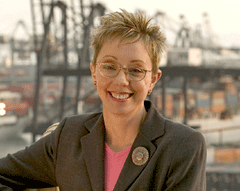
Dr. Geraldine Knatz is Executive Director of the Port of Los Angeles. (Courtesy of the Port)
FREEMAN: We’ve been told by the experts that whether it’s LNG or biodiesel – whatever you burn – if you burn something you’re gonna have a tiny, small particulate matter. And these folks are right there at lung-level breathing that stuff. So to have a vehicle that will not burn anything that will just be run on electricity is a fundamental cleanup. This is not show; this is really tell.
[GEARS CLICK IN PLACE; MAN SAYS ‘LET’S START IT UP HERE’; ELECTRIC TRUCK ENGINE WHIRS ON]
FLUEGAL: A lot quieter than your standard diesel truck, huh? Yeah, it's real nice.
[ELECTRIC TRUCK RUNNING]
LOBET: Michael Fluegal is a vocational laborer at the port and drives a lot of heavy equipment.
FLUEGAL: We're real proud of it. When I got involved with the truck myself, you know, I had my doubts. But we’ve threw everything but the kitchen sink at it and it just keeps performing, so it’s just short of spectacular. It’s – we've hauled as much as sixty-eight thousand pounds on this truck, and it just keeps on ticking.
[TRUCK DECELERATES; POWERS DOWN AND SWITCHES OFF]
LOBET: Experts agree running a vehicle on electricity, even when half of it comes from coal, as here, is much cleaner than burning diesel. But David Freeman says the port plans to run the truck on solar, and already has the first megawatt out to bid.
The person who shepherded this project from ‘let's do it’ to ‘here it is!’ is Balwinder Samra. He's an electric vehicle expert who helped golf carts go electric, and sold electric delivery trucks in Mexico. He remembers when electric forklifts were new.
SAMRA: I still remember customers use to not believe us when we would go in and say this one is electric. And I was very surprised, once the economic analysis got around, that industry switched very fast.
LOBET: Samra was struck by how short the hauling distances were at the port, usually less than twenty-five miles to regional warehouses and railroad connections, and often less than half a mile from one spot in the port to another.
SAMRA: It was a ideal opportunity for electric vehicles.
LOBET: And with the cost of diesel skyrocketing, the timing seemed right, too. The electric trucks can cost seventy thousand dollars more than diesel trucks up front, but battery recharging saves money compared to fuel.
SAMRA: Just an example, if we tried to do this in 1980s, we had dollar-a-gallon type stuff so I would be right now telling you we can save you five thousand dollars a year. Not as compelling is it? Today, because of the pricing, we have a thirty-five thousand dollar argument, which at least perks up somebody's ears and they say let's talk about this more.
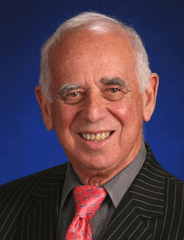
David Freeman heads the Los Angeles Harbor Commission. (Courtesy of the Port of Los Angeles)
LOBET: The team chose traditional lead-acid batteries for price and reliability. They hope a next-generation battery will increase charging speed and capacity. To keep the trucks operating, workers have to recharge them four hours at night, and also briefly during shift changes. They use a smart charger that can charge four vehicles at a time, and adjust the flow of juice to each one depending on need.
Samra's company, Balqon, is still working out the kinks in those distribution algorithms. He says when the frustrations of new-product development weigh him down, he remembers the reception the first truck got from port employees.
SAMRA: There were like twenty people whipping out their cell phones and trying to take the images of that thing. It was very exciting.
LOBET: Officials think half the eight thousand trucks needed at the port could be electric. That could potentially eliminate two hundred tons annually of one principal pollutant: NOx. Even before the Port of LA's electric trucks are announced, Samra says he's been deluged with calls.
SAMRA: A lot of interest from West coast ports, Canada, Italy, Pacific Asia. There’s a lot of people calling us. It just seems like a lot of people were waiting for this to happen.
LOBET: Over the last decade the southern California seaports have been shaken by their reputation as the largest polluters in the nation's most polluted region. Angry communities have sued and shut down nearly all port expansion. Now the new leadership at the ports hopes they'll be able to do something that didn't seem possible a few years ago: expand, and get much cleaner, at the same time.
For Living on Earth, I’m Ingrid Lobet in Los Angeles.
[HUM OF TRUCK ENGINE]
[MUSIC: Louis Armstrong: “When It’s Sleepy Time Down South” from Live At The 1958 Monterey Jazz Festival (Monterey Jazz Festival Records 2007)]
Related links:
- Electric Truck Manufacturer
- Port of L.A.'s Clean Truck Program
- Port of Long Beach Green Port Policy
- Community Blog on Clean Ports
Allergic Reaction to Climate Change
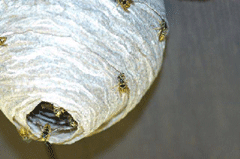
Aerial yellow jackets on a nest. (Photo: Jeffrey Demain)
GELLERMAN: Ragweed allergy sufferers - beware the Ides of August and beyond!
According to the American Academy of Allergy Asthma and Immunology, August is the start of ragweed season – bringing itchy eyes to 36 million Americans.
Alaskans are among the first to feel the effects and experts say the “gesundheit” problem there is getting worse due to climate change. In Alaska, temperatures have risen four times as fast as the rest of the planet. Not only does the longer growing season mean escalating pollen counts, it also means biting bugs and stinging insects are having a field day.
Jeffrey Demain has felt the pain. He’s founder and director of the Alaska Allergy, Asthma and Immunology Center in Anchorage.
Dr. Demain, welcome to Living on Earth.
DEMAIN: Thank you very much, it’s my pleasure to be here.
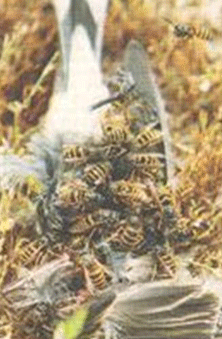
Yellow Jackets devour a bird. (Courtesy of Jeffrey Demain)
DEMAIN: Well, actually, we stay pretty busy throughout the state. Your comment is correct, we certainly have seen more intense pollen cycles, both in number of pollen levels as well as duration of the cycles over the past few years. I would say our tree pollen cycle has increased by three weeks, and the same with our grass pollen cycle.
GELLERMAN: What about stings from insects?
DEMAIN: Well, that’s a very interesting topic. This is an area that I’ve been researching for a little over a year. We experienced our first two deaths in Alaska from yellow jacket stings in 2006 – this occurred in Fairbanks. Well, that alerted our attention, so we started looking at why did this happen. What changed? And when we started looking at this we found that there was about a ten-fold increase in the number of yellow jackets in Fairbanks. A biologist captured several just on his property and estimated that he killed 12,000 yellow jackets just there alone.
We looked at the data from a hospital in Fairbanks and found that the number of people seeking medical attention in the emergency department for stings rose from approximately 40 a year to 178 a year. And when we took that back to between 1990 and 1994, there were actually zero occurrences. So, there was definitely a rise in Fairbanks.

Jeffrey Demain is the Director of the Allergy, Asthma & Immunology Center of Alaska.(Courtesy of Jeffrey Demain)
GELLERMAN: So, why are we seeing more stings and more cases of allergies in Alaska?
DEMAIN: Well, we’ve been following the changes in climate – now, changes in climate not only include temperature warming during the summer, but also higher winter temperatures – and that actually may be the more important one. But, in addition to that, with these temperatures and more precipitation, we’re seeing the migration of alpine tundra. So it’s actually disappearing, and it’s being recaptured by other flora and fauna, which is gonna create more grasslands, more forests, and actually, probably, relocate and redistribute certain insect species.
GELLERMAN: I was reading your research and you say that 90 percent of the tundra in Alaska is gonna be lost in the next hundred years?
DEMAIN: That’s what the prediction is. And a lot of these predications were made in 2001, and we’re – right now, just seven years later – we’re 30 years ahead of those predictions.
GELLERMAN: So, what does that mean in terms of allergies and insect bites going forward?

Yellow jackets on a nest. (Courtesy of Jeffrey Demain)
GELLERMAN: What are the medical implications of climate change you think we’ll see in the future?
DEMAIN: Well, I think, you know, you brought up allergies, and I do believe we’re gonna see an increase in severity of simple allergic rhinitis – which is actually very significant, and it affects people’s quality of life. Along with that, asthma occurs in at least a third of patients that have allergies, so I believe we’re gonna see intensification of asthma, especially patients that have pollen sensitivities.
We’re already seeing a significant impact with some of the redistribution of insects and people have allergic reactions and requiring more aggressive therapy for that. In fact, we’re now seeing fatal events as a result of it.
And I think beyond that – if you step back again a little further – we’re looking at, what else is impacted by climate change? There’s very, very, very good evidence that we’re seeing dramatic increases in malaria, dengue fever, viral encephalitis throughout the world, even as a close as Mexico and South America. And these are directly impacted by climate change. Even things like hantavirus in the southwestern United States, as well as plague in the southwestern United States –and West Nile virus – all of these are probably a reflection of shifts in the environment and shifts in climate.
GELLERMAN: Dr. Demain, thank you very much.
DEMAIN: You’re very welcome and it was my pleasure.
GELLERMAN: Dr. Jeffrey Demain is founder and director of the Alaska Allergy, Asthma and Immunology Center in Anchorage.
[MUSIC: Tortoise “Along The Banks Of The Rivers” from Millions Now Living Will Never Die (Thrill Jockey Records 1996)]
GELLERMAN: Coming up: Trekking Java in search of a forest and a nation’s future. Just ahead on Living on Earth.
[MUSIC: Ted Nash “Mr. Yunioshi” from The Mancini Project (Palmetto Records 2008)]
Java Trees
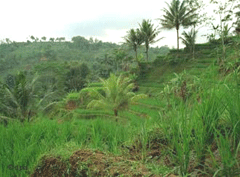
Indonesia is home to about ten percent of the world's rainforests. (Courtesy of Deutsche Welle)
GELLERMAN: It’s an encore edition of Living on Earth, I’m Bruce Gellerman. The rich forests of Indonesia have helped fuel the island nation’s fantastic economic growth. The tropical woods were turned into pulp for paper and hardwood furniture - finding ready markets around the world.
But Indonesia’s economic miracle came at a devastating price for the nation - where millions of acres were deforested - and the world.
Indonesia is the third largest emitter of greenhouse gases and 85 percent of that comes from cutting down trees - largely in the lush lowlands on the island of Java where Michael Lawton has our story, originally produced by Radio Deutsche Welle and Java’s Radio Bass FM.
[BIRDS CHIRP]
LAWTON: A roof of green leaves, the sound of trickling water, tall trees towering to the sky. Wildlife. That’s what people usually associate with forests. But if you’re looking for them in the teak forests on the island of Java, you could be very disappointed.
[SOUND OF LEAVES CRUNCHING]
LAWTON: We trekked through some of the teak forests on Java, from Bojonegoro in the east to Randublatung, Blora in the west. We started early in the morning, just before the first downpours, but a merciless sun was pounding on our backs, rivers of sweat were trickling down our faces. The only thing that remotely reminded us of the typical feel of a forest is the sound of dry teak leaves crunching under our feet, and perhaps the sound of birds chirping from afar. The teak trees here make up a somewhat unnatural forest. They’re planted in rows with regular spaces between them. Most of the trees are mere saplings. The diameter of the trunks is still around 30 centimeters. Bojonegoro was once known as ‘Teak City.’ It was surrounded by the vast teak forests of Java.
[ROOSTER CROWS]
LAWTON: Yanti (phonetic spelling), an elderly woman living in the village of Sumbergo (phonetic spelling) in the district of Margomulyo, is still able to tell her grandchildren about those days.
[YANTI SPEAKING INDONESIAN LANGUAGE]
VOICEOVER: It was very comfortable. There used to be mahogany trees on the left and teak trees to our right—big and tall ones. Monkeys were living in the forests back then, but nowadays there’s nothing left.
LAWTON: This teak forest was once one of the oldest and best-managed forests in Indonesia. But now there are many problems which threaten to destroy state teak forests in Java: overexploitation, forest fires, illegal logging and theft are just a few of them. There’s also corruption and mismanagement by the state forestry authorities. The political change which came with the downfall of President Suharto in 1998 proved to be disastrous for Java’s teak forests. People started cutting down teak trees and literally plundered the forests.

Indonesia is home to about ten percent of the world's rainforests. (Courtesy of Deutsche Welle)
[MAJIA SPEAKING INDONESIAN LANGUAGE]
VOICEOVER: It was crazy. People were no longer scared to go into the forest with trucks, cars, and even motorbikes.
LAWTON: Exi Mahardana Wijaya (phonetic spelling), an environmental activist in Randublatung, tries to describe the damage done.
[MAJIA SPEAKING INDONESIAN LANGUAGE]
VOICEOVER: They took axes and saws with them. This was an expression of anger because most Indonesians never felt that the forests belonged to them. A lot of state forestry offices were burnt down.
LAWTON: Between 1998 and 2002, tens of thousands of hectares of woods were destroyed. Indonesian forest rangers had to stand by and watch helplessly. Sometimes they were even chased and beaten up by the people, says Robi (phonetic spelling), a forest ranger from Bojonegoro.
[MAN SPEAKING INDONESIAN LANGUAGE]
VOICEOVER: In those days they were after us, not the other way around. We were only two or three rangers and there were whole villages plundering the woods. At that time the scale of thefts was really unbelievable.
LAWTON: According to some figures, around 150,000 hectares of teak forest were destroyed by poor villagers following the political and social chaos in the post-Suharto era. But the plundering still continues, even if at a lower level. Krisdomo, head of the Forest Stakeholders Association in the region of Parangantuban (phonetic spelling), says that although vast areas of forest have been destroyed, it’s not benefited the local people. They still live in poverty.
[KRISDOMO SPEAKING INDONESIAN LANGUAGE]
VOICEOVER: These actions have not made any impact on the lives of the villagers who live near the forest. Their economic situation has not improved. Outsiders are still the ones who reap the money from the plundering. This is our main concern. We have to tackle both problems at the same time. On the one hand, we need to preserve our forests. But on the other hand, we want to help the people around here economically.
LAWTON: The forest destruction between 1998 and 2002 is a dark chapter in the history of the state forest company Perhutani, which is part of the Indonesian Forest Department. The Indonesian government amended the law on forest preservation in 1999. In 2002, based on this new law as well as past experiences, Perhutani designed a program called community-based forest preservation. This program tries to include locals in forest preservation measures. Villagers who live near the forests are encouraged to help keep the forests in tact. As a reward, they can use land surrounding the forests for their needs. They’re also entitled to 25 percent of the earnings from the forests’ produce. Community-based forest preservation might sound like a good idea at first, but the program has yet to who any evidence of success.
[SOUND OF BIRDS CHIRPING]
LAWTON: We went to visit one village, Randublatung, which has become infamous. It now has a nickname: Kampum Kaum Blandong (phonetic spelling), or ‘the village of the pillagers.’ Three people agreed to talk to us. All three of them are ‘blandong’ (phonetic spelling), or illegal loggers. One of them, Hairo (phonetic spelling), which is not his real name, says that government programs have never been introduced into his village.
[HAIRO SPEAKING INDONESIAN LANGUAGE]
VOICEOVER: We can be called thieves since we’re actually operating without having any permits from Perhutani. But we really are forced to do this. If we don’t know where to get money to buy food, we go into the forests.
LAWTON: But are the illegal loggers and the thieves the only ones to blame for the destruction of Java’s teak forest. Yuliani (phonetic spelling) an environmental activist in Bojonegoro, blames the sketchy and ambiguous measures which the government has tried to introduce to preserve the peak forests. A so-called master plan for East Java, states that the area of the plan is to be increased but no one knows how this is going to be implemented.
[YULIANI SPEAKING INDONESIAN LANGUAGE]
VOICEOVER: They say the forest is to be increased from 28 to 36 percent, but at the same time, there’s going to be more land for industry and housing. So, what are they going to sacrifice to plant more trees? Are they going to stop building houses or are they going to take away farmland? That’s not possible. And it’s even more unlikely that they just limit industry in favor of some trees.
LAWTON: Another problem, adds Yuliani, is the unclear definition of forest areas. Most of the two and half million hectares of the Perhutani land, which is characterized as forestland, has been cleared of trees entirely. Some patches are barren. Other parts are used as farmland. What’s left of the teak forest is a commercial forest, planted to be harvested, but not a conservation forest. Until the trees have grown enough to build a new, natural forest, the land is going to remain barren and unwelcoming.
[SOUND OF BIRDS CHIRPING]
LAWTON: The old Javanese forest only exists in fairy tales, the kind that Yanti tells to her grandchildren.
GELLERMAN: Our story about Java’s forest comes to us courtesy of Radio Deutsche Welle, and Radio Bass FM. It was reported by Ging (JINJ) Ginanjar and Ari Bathara and presented by Michael Lawton.
[MUSIC: Marc Ribot “Shh Shh” from Party Intellectuals (Pi Records 2008)]
Related link:
Radio Deutsche Welle's "Living Planet"
Is Chicken Little Right?
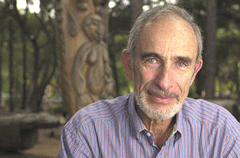
Paul Ehrlich (Photo: Linda A. Cicero/Stanford New Service)
GELLERMAN: Well, Java’s forests are just a part of the planet that’s in peril. According to the UN report "Global Environment Outlook 4" The world is hurtling headlong to disaster. Achim Steiner is executive director of the panel that produced the study.
STEINER: The sobering and not surprising findings are that on virtually all major variables of development, we still have to conclude that the signs are pointing downwards. We have not turned the corner on major issues such as energy, climate change, loss of biodiversity, decline in fisheries, deforestation.
GELLERMAN: The UN panel even warns that "mass extinction" is possible. Of course, there have been bleak warnings about the fate of the Earth before. Among the most famous of pessimistic predictions were from biologist Paul Ehrlich.
In 1968 Ehrlich wrote "The Population Bomb," a landmark book in which he predicted that as a result of an exploding population, by 1985, quote: 'The battle to feed all of humanity will be over,' and that, 'In the 1970’s and 80’s hundreds of millions of people will starve to death in spite of any crash programs embarked upon now.'
Paul Ehrlich is Bing Professor of Population Studies at Stanford University now. We called him up to see if he’s changed his perspective.
Hi, Professor Ehrlich.
EHRLICH: Nice to be here.
GELLERMAN: You know, this UN report is pretty pessimistic. Uh, and you’ve got a history of being something of a professional pessimist. Is it time for me to start walking down the street with a sign saying ‘The End is Near’?
EHRLICH: Uh, I think it’s time for people to take very seriously the things we’re doing to our life support systems. In other words—it’s not just me that’s pessimistic. In 1993, 58 academies of science said—that is basically all the academies of science in the world—said if we don’t change our ways, we’re doomed. And 1500 of the world’s leading scientists sent out a statement called “World Scientists’ Warning to Humanity,” said exactly the same thing. It wasn’t covered in the press at all. The scientific community has been trying to warn society about the various things we’re facing and it just hasn’t penetrated the media or certainly governments.

Paul Ehrlich (Photo: Linda A. Cicero/ Stanford News Service)
EHRLICH: Forty years ago and perfectly correct. We still have about a billion people who don’t get enough food to function properly. In 1968 in the same book I warned about the possibilities of global warming, and that’s something the scientific community has known about since about 1898. None of this stuff is new. It’s just a massive report happened to come out of the UN saying ‘all the trends are in the wrong direction.’ And they’re perfectly correct but it’s something again, the scientific community has been saying as loud as it could for a long time.
GELLERMAN: So we’re facing an existential crisis?
EHRLICH: We’re facing a crisis in which the way in which many of us live will not be possible for the vast majority of people—sometime in the relatively near future. Hopefully after I’m dead, but maybe not.
GELLERMAN: Well according to the UN report, by 2050 there will be about 9.7 billion people on the planet. Is that in excess of the carrying capacity of the planet?
EHRLICH: Certainly in anything like today’s lifestyle. You know if you try to move to a battery—what my colleague calls a battery-chicken type of world, in which everyone has the absolute minimum to keep them alive—it might be possible.
GELLERMAN: Did you say 'battery chicken?'
EHRLICH: Battery chickens are these situations where you raise billions of chickens in one building, you know where every chicken as a square foot and just is in there and gets fed and uh, grows. That’s the battery-chicken world, where everybody is living the absolutely minimum standard of living so you can maximize the number of people. If we want, for example, the United States to go on for thousands and thousands of years, the way to do it isn’t to see how many people we can cram in in the next 20. You’ve got to remember we’re at about 6.6 billion now, talking about adding about 2.5 billion more.
First of all, 2.5 billion is 500 million people more than were on the planet when I was born in 1932. So we’re adding more than existed when I was born. Second, the next two and a half billion are going to be a lot more expensive to take care of environmentally than the previous 2.5 billion because people are smart, they farm the best lands first. You know you can’t get oil by sticking a pointed stick in the ground in Pennsylvania anymore. You got to drill down a couple of miles. And water has to be transported long distances. And I think anybody who reads the newspapers and can count, can see that we’re in deep trouble just from the numbers of people versus the resources that are available. Ask them in Atlanta, where they’re running out of water. Ask them in Southern California, where climate change is helping huge fires to devastate areas. I was just in Brazil, and the Pantanal swamp area was burning and the Cerrado, the savannah areas south of the Amazon, were burning in record bouts. So, you know, you just have to look around to see what’s happening.
GELLERMAN: Well Professor, I can’t resist the word play temptation. You know, you say battery chicken, some people say Chicken Little.
EHRLICH: Well they say Chicken Little but again, I warned 40 years ago about climate change, what do we have going on now? I warned 40 years ago about emergent diseases, what do we have now? I warned 40 years ago that if we didn’t do something about the population situation, people would still be hungry. Well, we’ve got many, many millions of people hungry. So, Chicken Little says the sky is falling. Well, maybe Chicken Little is right.
GELERMAN: According to the UN report, each person on the planet needs about 22 hectares. But I’m thinking, you know, there’s Hong Kong, there’s New York, you know, uh—
EHRLICH: Well, that’s right but the thing you got to remember is that the people in New York don’t live on New York. They import stuff from acres all over the rest of the world. Where, it’s a common fall—it’s actually been named by the scientific community ‘the Netherlands fallacy,’ the idea that the whole planet can be as crowded as the Netherlands. And of course it’s not people versus area, it’s people versus the resources that support them. And those resources include things called ‘sinks,’ like the capacity of the atmosphere to absorb carbon dioxide. That’s a very important resource for the planet. It’s one we’re overusing at the moment.
GELLERMAN: Are we as a species capable of comprehending and dealing with problems of this magnitude?
EHRLICH: Sure we are. We’re perfectly capable of it. We’re the dominant animal on the planet. We’re in many ways brilliant but we haven’t gotten the political and ethical will together to do the things we ought to be doing. And the educational system is deteriorating. The media don’t generally cover this stuff. I mean if you look at the top stories in the media, how often do they deal with the fact that we’re within decades of losing our civilization. It’s almost never mentioned. There are some things now that’s coming out but for instance you would think, watching the media today, that the only big threat is climate change. But of course many people feel for instance that the number of toxic substances we’re adding to the environment are an even bigger threat. In many villages in the Arctic and sub Arctic, there are only half as many male babies being born as female babies and it’s likely a sign of the hormone-mimicking chemicals that we manufacture, release into the environment, and that are carried by the climate systems to the poles. The threat of emerging diseases—the first one of course, has been AIDS, the first really big one in recent decades—but the more people we have, the greater the threat—particularly to the ones that malnourished—of new plagues taking over, a new flu, and so on. So that’s considered a huge threat. And the loss of biodiversity, the other organisms that are a working part of our life support systems, is also a huge threat. I mean, even economists are looking at issues like: are we consuming too much now? In other words, the scholarly community is enormously concerned and the general public and particularly our so-called leadership is utterly ignorant so it’s not a great situation.
GELLERMAN: So it has not reached the tipping point?
EHRLICH: We don’t know. But what other choice do we have but to try and change so that if we haven’t reached the tipping point, we don’t reach it, because the tipping point is going to be miserable and an awful lot of people will die and lifestyles will change very, very dramatically, and so we don’t want to do that so you know, I can’t be incredibly optimistic about what we’re going to do. What we can say is that societies can change very rapidly when the time is ripe. Look for instance how rapidly the Soviet Union disappeared when none of us expected it to. When I was a kid, lynchings were common in the south of the United States. They aren’t any more. In other words, things can change very rapidly. We don’t fully understand why but when the time is ripe, they change and I think that your chore and mine is to try to ripen the time.
GELLERMAN: Well Professor, it’s been a real pleasure talking with you. Thank you very much.
EHRLICH: It’s a pleasure to me too, thank you very much.
GELLERMAN: Paul Ehrlich is Bing Professor of Population Studies at Stanford University.
Related link:
To see UNEP's fourth Global Environment Outlook report, click here
[MUSIC: Charlie Hunter/China Smith/Ernest Ranglin “I’ve Got The Handle” from Earth Tones (Nature Sounds 2005)]
GELLERMAN: Coming up: Boldly going where Hollywood has gone before. Stay tuned to Living on Earth!
ANNOUNCER: Support for the Environmental Health Desk at Living on Earth comes from the Cedar Tree Foundation. Support also comes from the Richard and Rhoda Goldman fund for coverage of population and the environment. And from Gilman Ordway for coverage of conservation and environmental change. This is Living on Earth on PRI, Public Radio International.
[MUSIC: Monty Alexander: “Could You be Loved” from Stir It Up (Telarc Records 1999)]
Vida Verde
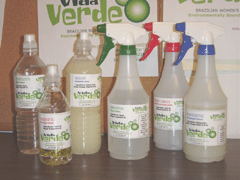
(Courtesy of Brazilian Women's Group)
GELLERMAN: You’re listening to an encore edition of Living on Earth, I’m Bruce Gellerman.
Many of the things we use to wash bathrooms, unblock drains, and make ovens spic and span contain toxic ingredients. Lurking underneath many a kitchen cabinet are chemicals hazardous to your health. For professional cleaners - many of whom are women, and many of them immigrants - daily, repeated exposure can make them sick.
There are safer alternatives. Clean and green are the new watch-words for many household products advertised on TV these days, but getting the word out to non-English speaking workers can be difficult. That’s where a house-cleaning coop in Boston comes in, as Catherine Elton reports.
[SOUND OF WOMEN SPEAKING IN PORTUGESE]
ELTON: In the basement office of the community organization the Brazilian Women’s Group, several Brazilian housecleaners sit around tables and discuss the agenda for an upcoming meeting. The women are part of Vida Verde, a new green cleaning cooperative that began last December.
Monica Chianelli, a housecleaner and the coop’s coordinator, helped launch Vida Verde. She says housecleaning is the number one occupation for the women of Massachusetts’s large Brazilian immigrant community.
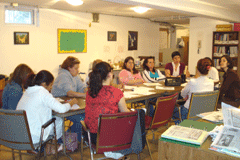
(Courtesy of Brazilian Women's Group)
ELTON: But along with those benefits, coop member Carla de Castro says, came some problems.
CASTRO: I felt a headache all day long and dizzy, and the end of the day you can’t smell anything because you just lost your sensitivity to smell. I can feel better if I stop to use. But I know if I continue to use for months and years, I know it’s going to make me feel very sick.
ELTON: Castro wasn’t the only one feeling this way. Monica Chianelli worked with immigrant activists, interviewing hundreds of Brazilian housecleaners. She heard many complaints like these and about respiratory problems, nose bleeds, fainting and skin rashes. Some of the women said they felt so bad they considered quitting the business.
So Chianelli and the activists started promoting green cleaning products. Their work caught the attention of epidemiologist David Gute of Tufts University. When he received a grant from the National Institute of Occupational Safety and Health to study immigrant occupational health issues, a chunk of it went to jumpstart the Vida Verde Cooperative.
GUTE: What we hope to get is a group of coop members who will take seriously the responsibilities of protecting their own health and also protecting, obviously, the environmental heath of the clients homes in which they work. I think that there will be a greater sense of control in their own lives and businesses as a result of this.
ELTON: Research shows there’s a higher incidence of asthma among professional cleaners as compared to other workers. And other studies examine indoor air pollutants that could affect human health. A four-year study recently completed at the University of California Berkeley looked at whether routine use of common cleaning products and air fresheners affect indoor air quality. Researchers studied solvents called glycol ethers – a toxic air contaminant and common ingredient in cleaning products. They also looked at other solvents called terpines. They’re the seemingly innocuous ingredients which give products lemon or pine scent. But terpines can create dangerous formaldehyde when they mix with ozone found in indoor air.
William Nazaroff was the lead scientist on the Berkeley study.
NAZAROFF: What we found was that the levels of exposure, both to glycol ethers and to secondary pollutants from terpine use, could be high enough to warrant further attention and some concern, especially under scenarios where high amounts of the products are being used in spaces that are small and not very well-ventilated.
ELTON: But Nazaroff is quick to point out there is still a lot that hasn’t been proven about the relationship between these toxic air contaminants and the health problems of housecleaners.
NAZAROFF: At this point we’re not able to connect the dots to say that the chemical exposures are, in fact, the reason that occupational asthma is elevated in this group. But more work is going to have to be done to try to fill in the gap between those two end points.
ELTON: And without that epidemiological data to prove a connection, Tufts’ David Gute says not much can be done to force a change in the formulations of the products.
GUTE: There has always been this uneasy tension in the regulatory community about when a chemical is safe to use. The prevailing wisdom has usually been that a chemical is safe until proven guilty. The vast majority of chemicals, either newly developed or new combinations, are not screened in any meaningful way prior to release.
ELTON: Vida Verde coop members aren’t the only ones unwilling to wait for science and government regulations to catch up with their concerns. The demand for natural home-cleaning products has taken off recently. And several states now require janitors clean schools and other public buildings with products that meet the standards of the nonprofit certifying company Green Seal. Currently, there is no certification standard for home cleaning products. But Green Seal expects to start certifying these products, too in the coming months.
Members of the Vida Verde Coop, however, opted for another approach.
[SOUND OF FILLING BOTTLES]
ELTON:On a recent morning, Monica Chianelli and another coop member make their own natural cleaning products. Members take turns and mix enough for others to use when they clean.
CHIANELLI: We made Amazing, now we are going to make Magic. Six cups of water and six cups of vinegar.

(Courtesy of Brazilian Women's Group)
ELTON: They use recycled plastic bottles to store the products, and put on Vida Verde labels to identify them. And then they’re ready to use them in their clients’ homes.
[SOUND OF MONICA CLEANING]
ELTON: In a large Victorian house outside of Boston, Monica Chianelli starts to clean in the kitchen.
CHIANELLI: First I used Fantastick that is a product we made with soap and borax. After that to rinse I use Amazing that is something with water and vinegar. Because vinegar dissolves the soapy films.
ELTON: Homeowner Katrin Kaufer says she is happy with the results.
KAUFER: I have young children. I’m glad that they are not exposed to any chemicals in the house. It’s good for our family and the environment as a whole. I don’t have any reason not to do it.
ELTON: Members of Vida Verde say that since they switched products their health problems have disappeared. And Coop members are hoping to convince more housecleaners to change the way they clean. They’re making presentations to housecleaners around Massachusetts to show them how to make their own natural products---and why.
For Living on Earth, I’m Catherine Elton in Boston.
[SOUND OF CLEANING AND SPRAYS]
Related links:
- Vida Verde Co-op group
- Press release on Tufts grant to address immigrant occupational risks
- Dr. William Nazaroff, University of California, Berkeley
[MUSIC: Mary Fertig “Neguinha (Sweetheart)” from Brazilian Footprints (F Major Records 2008)]
Big Screen Science
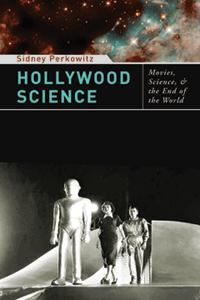
Hollywood Science: Movies, Science and the End of the World (Photo: Columbia University Press)
GELLERMAN: Now, from chemicals under the counter to a close encounter of a different kind.
[SOUND FROM THE MOVIE “ET” – “ET phone home”]
GELLERMAN: Extraterrestrials are extra popular on the big screen. In fact, a third of the top grossing movies are science fiction films. Think: Jurassic Park, The Invasion of the Body Snatchers, AI, Blade Runner, Spiderman.
Sci-Fi flicks feature flights of fantasy that can transport us beyond our imaginations, but not all the science in the movies measures up to the standards of Sidney Perkowitz. He’s a physicist at Emory University and author of the book, “Hollywood Science; Movies, Science and the End of the World”.
Professor Perkowitz, welcome to Living on Earth.
PERKOWITZ: My pleasure, Bruce. Thanks for having me.
GELLERMAN: Or should I say ‘Klaatu barada nikto’?
PERKOWITZ: Well, that would win you favor with a lot of science fiction fans, that’s for sure.
[SCENE FROM A MOVIE; WOMAN SAYS ‘KLAATU BARADA NIKTO’]
GELLERMAN: That’s from the 1951 classic “The Day the Earth Stood Still.” You have a picture of it right on your book.
[WOMAN REPEATING ‘KLAATU BARADA NIKTO’]
GELLERMAN: What does ‘Klaatu barada nikto’ mean?
PERKOWITZ: Apparently it’s instructions to the deadly robot Gort to do the right thing after his boss Klaatu has been shot down by the military.
GELLERMAN: Well, let’s listen to some of “The Day the Earth Stood Still.” This is the original:
[BROADCAST JOURNALIST ANNOUNCES ‘WE INTERRUPT THIS PROGRAM TO GIVE YOU THIS NEWS BULLETIN FROM ONE OF OUR NAVAL UNITS AT SEA. A LARGE OBJECT TRAVELLING AT SUPERSONIC SPEED IS HEADED OVER THE NORTH ATLANTIC TOWARD THE EAST COAST OF THE UNITED STATES’ - SIRENS WAIL]
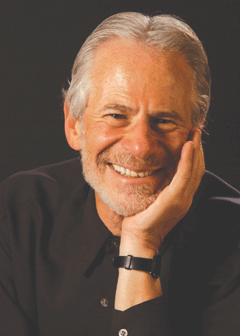
Sidney Perkowitz (Photo: Columbia University Press)
PERKOWITZ: At the time, which was the 50’s—and we have to cast our minds back to what that meant. We were in the middle of the Cold War and it was just a few years after an atomic bomb had first been exploded. So this is a movie that has some science in it—or pseudo science—but really it has a message: be very careful with nuclear weapons. And that makes it a classic because of the message it carries but also because it’s a good, tightly constructed movie.
[SCENE FROM A MOVIE, MALE VOICE: ‘I CAME HERE TO GIVE YOU THESE FACTS, BUT IF YOU’RE CERTAIN TO EXTEND YOUR VIOLENCE, THIS EARTH OF YOURS WILL BE REDUCED TO A BURNED OUT CINDER’]
GELLERMAN: Science fiction has been a huge part of the film industry from the—well, almost from the very beginning.
PERKOWITZ: I was surprised when I researched it. If you do the sums it turns out there’s been at least one major science fiction film made per month since 1902 and 1902 is not very long after movies began. So yes, it’s been a continuing thread for decades and decades.
GELLERMAN: The one I remember is I think from the 20s. It’s “Metropolis,” silent film.
PERKOWITZ: I put that on my ten-best list because it was such a strong and far-seeing film. Although it was made in the 20’s, it has things in it that still many directors could be envious of.
GELLERMAN: Like what?
PERKOWITZ: First of all, the powerful use of black and white. Of course that’s all they had, but this director Fritz Lang really knew how to use shades of gray. Secondly just the audacity of the projection. It talked about technology a hundred years in the future that we still don’t have.
GELLERMAN: Sometimes the science kind of speeds over the science fiction and these films get it wrong. I’m thinking of Star Trek, when they have transponders. And now we have cell phones that make transponders look like antiques.
PERKOWITZ: Absolutely. I mean, basic science maybe the movies don’t do so well in projecting technology. They’re phenomenal but the real technology is even more phenomenal. So your example of cell phones is a perfect illustration of that. However, our cell phones won’t reach from planet to planet and I guess in Star Trek maybe, the transponders will do that.
GELLERMAN: Let’s talk about some of the science fiction movies that really, well, for lack of a better word they’re real stinkers.
PERKOWITZ: Okay (laughs)
GELLERMAN: One of the ones topping your list is “The Core.”

Hollywood Science: Movies, Science and the End of the World (Photo: Columbia University Press)
GELLERMAN: I hate when that happens.
PERKOWITZ: You know, it just makes a bad day. It could ruin a weekend. And in this movie it ruins the whole earth. So they put in this premise and every movie is allowed one premise. Even if it’s wrong, you’re allowed one premise. So that’s their premise. But every statement about science after that premise is dead wrong. It’s remarkable how wrong this movie is.
GELLERMAN: But is good science really the object of science fiction? Isn’t it, well, to entertain? Movies are about making money.
PERKOWITZ: Bruce, I think that’s a great point. I think we have to recognize that Hollywood studios are not in the business of making instructional, educational films. They want to entertain. My take on this, as a scientist, is we should accept that fact and then use the movies as they are and use the science in them to teach some science. Even if the science is wrong you can use it to teach science. And I think that would be a smart approach for the future.
GELLERMAN: Let’s listen to—well, there’s no mistaking what this film is”
[THEME FROM “A SPACE ODYSSEY”]
GELLERMAN: Of course, this is from Stanley Kubrick’s extraordinary film “2001: A Space Odyssey.”
[THEME FROM “A SPACE ODYSSEY”]
PERKOWITZ: People who study the subject seriously say that that movie and “Close Encounters of the Third Kind” are the two films that lifted science fiction out of B movie status into major movie status. So what you say is absolutely right and again, those of us who saw the movie when it first came out remember being stunned by what were just the most remarkable special effects you could imagine at the time.
GELLERMAN: Some science fiction movies have made a real contribution to our consciousness and have consequence. I’m thinking of the movie “Soylent Green.”
[SCENE FROM “SOYLENT GREEN:” NARRATOR SAYS ‘NEW YORK CITY, IN THE YEAR 2022. NOTHING RUNS ANY MORE, NOTHING WORKS.’ SOUND OF PEOPLE SHOUTING. MAN CONTINUES ‘BUT THE PEOPLE ARE THE SAME. AND THE PEOPLE WILL DO ANYTHING TO GET WHAT THEY NEED.’ MAN SHOUTS ‘THIS IS THE POLICE!’ NARRATOR SAYS ‘WHAT THEY NEED MOST IS SOYLENT GREEN,’ POLICEMAN SHOUTS ‘THE SUPPLY OF SOYLENT GREEN HAS BEEN EXHAUSTED’]
GELLERMAN: That could’ve helped give birth to the modern environmental movement.
PERKOWITZ: Yes, that seems to be very, very true. That movie goes back to the 1970’s. It’s about a world set in the 2000’s—2020 or so—in which environmental badness has really ruined the Earth. You can’t grow enough crops to feed people. And that was an example of a movie that pointed out to quite a wide audience the consequences of misusing our resources.
[MAN ASKS ‘WHAT IS THE SECRET OF SOYLENT GREEN?’]
GELLERMAN: I’m not going to tell the secret but boy—
PERKOWITZ: No, let’s not tell. So a lot of people have given that movie a bunch of credit for starting the green movement, people thinking about the environment. And a lot of people since then have picked that up.
GELLERMAN: “Soylent Green” was about global warming, too. Right?
PERKOWITZ: Absolutely. Everyone in the movie comments on the fact that winter has gone. There’s no more winter. It’s always too hot. Air conditioning is an unimaginable luxury. And that’s because of global warming. Also, there’s not enough food because global warming has killed plankton and in fact there’s now scientific evidence that that is happening. So that movie was quite foreseeing.
GELLERMAN: Science fiction movies really can and I think, the best ones do, excite the imagination. And then they have consequence in the real world. I’m thinking of something you wrote in your book. You wrote about MIT scientist Cynthia Breazeal who designed a robot called ‘Kismet,’ the most expressive robot of its time. And she said she got the idea—well, from R2D2.
[SOUND OF R2D2]
PERKOWITZ: Isn’t that remarkable? And even when the movie science is not correct—or maybe could be correct but it doesn’t yet exist—it has inspired young people to become scientists. I think that’s one spin off we don’t recognize as being a good, powerful effect of science fiction films. I don’t know that any sociologist has studied this but there’s tons and tons of anecdotal evidence that scientists who watch science fiction early become sparred toward that kind of career. It happened to me and many other people.
GELLERMAN: Well, okay professor. I want to thank you very, very much. It’s really been terrific. I’ve had a great time. Or maybe I should say, instead of goodbye, I should say—
[ARNOLD SCHWARZENEGGER SAYS ‘HASTA LA VISTA, BABY,’ SOMETHING EXPLODES]
PERKOWITZ: And may the force be with you, Bruce.
[MUSIC: John Williams “Star Wars – Main Theme” from “John Williams Conducts John Williams – The Star Wars Trilogy” (CBS Records Inc. 1990)]
GELLERMAN: Or as Mel Brooks says in the movie “Space Balls,” ‘may the Schwartz be with you.’ Sidney Perkowitz is author of the new book “Hollywood Science.”
Related link:
Hollywood Science: Movies, Science and the End of the World
[SOUND OF TUNING UP, LOW VOICES, WAVES]
GELLERMAN: We leave you this week in Lane’s Cove - a small rocky inlet on the northern coast of Massachusetts.
[MUSIC: “Lane’s Cove Musicians” recorded by Ashley Ahearn in Lanesville, Massachusetts (July 2006)]
GELLERMAN: On a warm summer’s eve, a small band of friends gather together at sunset to make music by the sea. Living on Earth’s Ashley Ahearn captured the scene and sound of this merry troop.
Living on Earth is produced by the World Media Foundation. Our crew includes Ashley Ahearn, Bobby Bascomb, Eileen Bolinsky, Ingrid Lobet, Helen Palmer, Mitra Taj and Jeff Young, with help from Sarah Calkins and Marilyn Govoni. Our interns are Kim Gittleson and Jessica Ilyse Smith. Jeff Turton is our technical director. Luke Borders engineered this week’s program.
Alison Lirish Dean composed our themes. You can find us at LOE dot org. Steve Curwood is our executive producer.
I’m Bruce Gellerman. Thanks for listening.
ANNOUNCER: Funding for Living on Earth comes from the National Science Foundation, supporting coverage of emerging science, and Stonyfield Farm: organic yogurt and smoothies. Stonyfield pays its farmers not to use artificial growth hormones on their cows. Details at stonyfield.com.
Support also comes from you our listeners, the Ford Foundation, the Town Creek Foundation, the Oak Foundation supporting coverage of climate change and marine issues; the Skoll Foundation, supporting social entrepreneurs around the world – uncommon heroes dedicated to the common good. Learn more at skoll.org; and Pax World Mutual Funds: socially and environmentally sustainable investing. Pax World: for tomorrow. On the web at paxworld.com.
ANNOUNCER: PRI, Public Radio International.
Living on Earth wants to hear from you!
Living on Earth
62 Calef Highway, Suite 212
Lee, NH 03861
Telephone: 617-287-4121
E-mail: comments@loe.org
Newsletter [Click here]
Donate to Living on Earth!
Living on Earth is an independent media program and relies entirely on contributions from listeners and institutions supporting public service. Please donate now to preserve an independent environmental voice.
NewsletterLiving on Earth offers a weekly delivery of the show's rundown to your mailbox. Sign up for our newsletter today!
 Sailors For The Sea: Be the change you want to sea.
Sailors For The Sea: Be the change you want to sea.
 Creating positive outcomes for future generations.
Creating positive outcomes for future generations.
 Innovating to make the world a better, more sustainable place to live. Listen to the race to 9 billion
Innovating to make the world a better, more sustainable place to live. Listen to the race to 9 billion
 The Grantham Foundation for the Protection of the Environment: Committed to protecting and improving the health of the global environment.
The Grantham Foundation for the Protection of the Environment: Committed to protecting and improving the health of the global environment.
 Contribute to Living on Earth and receive, as our gift to you, an archival print of one of Mark Seth Lender's extraordinary wildlife photographs. Follow the link to see Mark's current collection of photographs.
Contribute to Living on Earth and receive, as our gift to you, an archival print of one of Mark Seth Lender's extraordinary wildlife photographs. Follow the link to see Mark's current collection of photographs.
 Buy a signed copy of Mark Seth Lender's book Smeagull the Seagull & support Living on Earth
Buy a signed copy of Mark Seth Lender's book Smeagull the Seagull & support Living on Earth

